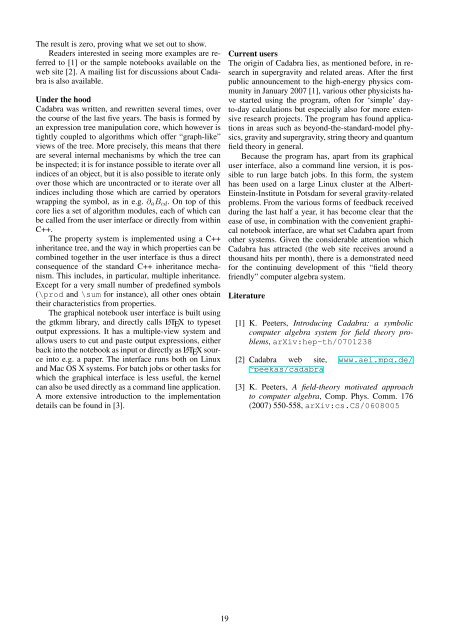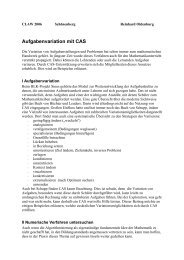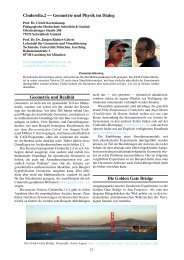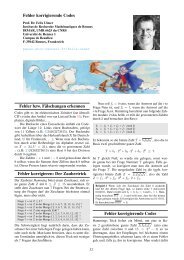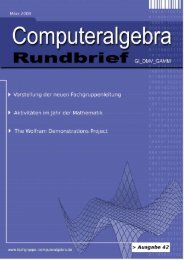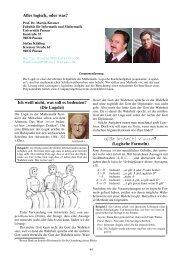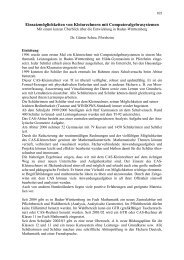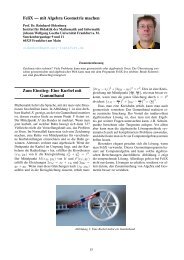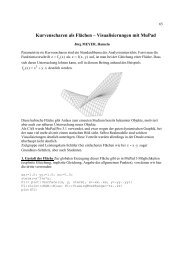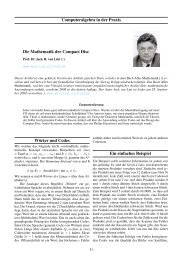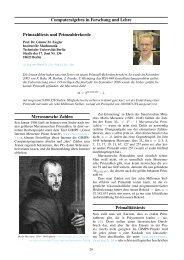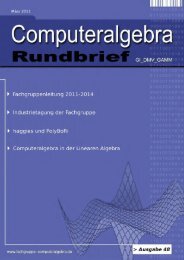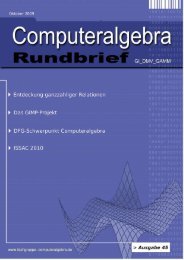mathemas | ordinate - Fachgruppe Computeralgebra
mathemas | ordinate - Fachgruppe Computeralgebra
mathemas | ordinate - Fachgruppe Computeralgebra
Sie wollen auch ein ePaper? Erhöhen Sie die Reichweite Ihrer Titel.
YUMPU macht aus Druck-PDFs automatisch weboptimierte ePaper, die Google liebt.
The result is zero, proving what we set out to show.<br />
Readers interested in seeing more examples are referred<br />
to [1] or the sample notebooks available on the<br />
web site [2]. A mailing list for discussions about Cadabra<br />
is also available.<br />
Under the hood<br />
Cadabra was written, and rewritten several times, over<br />
the course of the last five years. The basis is formed by<br />
an expression tree manipulation core, which however is<br />
tightly coupled to algorithms which offer “graph-like”<br />
views of the tree. More precisely, this means that there<br />
are several internal mechanisms by which the tree can<br />
be inspected; it is for instance possible to iterate over all<br />
indices of an object, but it is also possible to iterate only<br />
over those which are uncontracted or to iterate over all<br />
indices including those which are carried by operators<br />
wrapping the symbol, as in e.g. ∂aBcd. On top of this<br />
core lies a set of algorithm modules, each of which can<br />
be called from the user interface or directly from within<br />
C++.<br />
The property system is implemented using a C++<br />
inheritance tree, and the way in which properties can be<br />
combined together in the user interface is thus a direct<br />
consequence of the standard C++ inheritance mechanism.<br />
This includes, in particular, multiple inheritance.<br />
Except for a very small number of predefined symbols<br />
(\prod and \sum for instance), all other ones obtain<br />
their characteristics from properties.<br />
The graphical notebook user interface is built using<br />
the gtkmm library, and directly calls LATEX to typeset<br />
output expressions. It has a multiple-view system and<br />
allows users to cut and paste output expressions, either<br />
back into the notebook as input or directly as LATEX source<br />
into e.g. a paper. The interface runs both on Linux<br />
and Mac OS X systems. For batch jobs or other tasks for<br />
which the graphical interface is less useful, the kernel<br />
can also be used directly as a command line application.<br />
A more extensive introduction to the implementation<br />
details can be found in [3].<br />
19<br />
Current users<br />
The origin of Cadabra lies, as mentioned before, in research<br />
in supergravity and related areas. After the first<br />
public announcement to the high-energy physics community<br />
in January 2007 [1], various other physicists have<br />
started using the program, often for ‘simple’ dayto-day<br />
calculations but especially also for more extensive<br />
research projects. The program has found applications<br />
in areas such as beyond-the-standard-model physics,<br />
gravity and supergravity, string theory and quantum<br />
field theory in general.<br />
Because the program has, apart from its graphical<br />
user interface, also a command line version, it is possible<br />
to run large batch jobs. In this form, the system<br />
has been used on a large Linux cluster at the Albert-<br />
Einstein-Institute in Potsdam for several gravity-related<br />
problems. From the various forms of feedback received<br />
during the last half a year, it has become clear that the<br />
ease of use, in combination with the convenient graphical<br />
notebook interface, are what set Cadabra apart from<br />
other systems. Given the considerable attention which<br />
Cadabra has attracted (the web site receives around a<br />
thousand hits per month), there is a demonstrated need<br />
for the continuing development of this “field theory<br />
friendly” computer algebra system.<br />
Literature<br />
[1] K. Peeters, Introducing Cadabra: a symbolic<br />
computer algebra system for field theory problems,<br />
arXiv:hep-th/0701238<br />
[2] Cadabra web site, www.aei.mpg.de/<br />
∼ peekas/cadabra<br />
[3] K. Peeters, A field-theory motivated approach<br />
to computer algebra, Comp. Phys. Comm. 176<br />
(2007) 550-558, arXiv:cs.CS/0608005


